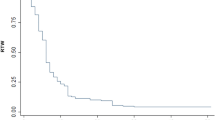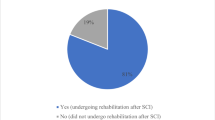Abstract
Design
Retrospective cohort study.
Objectives
To investigate paid work status and return to work (RTW) pathways after spinal cord injury (SCI).
Setting
SARAH Network of Rehabilitation Hospitals.
Methods
Participants were adults with traumatic SCI, aged between 18 and 60 years at the time of the injury, admitted between 2000 and 2017. In the first stage, socio-demographic, injury-related, and functional status data were collected from medical records. In the second stage, data on paid work, means of mobility, driving ability, return to study, ability to work, and satisfaction with the work status were collected through an online survey conducted between January and March 2020.
Results
A total of 154 participants were included in the sample. Of these, 90% were working at the time of SCI and 23% were engaged in paid work at the time of the study. Three RTW pathways were identified among those who were working at the time of the injury and: did not return to work (78%); returned to a different occupation (12%) and returned to the same occupation (9%). Number of post-injury complications, returning to study, good work ability, and satisfaction with the work status were predictors of paid work. The model’s adjusted coefficient was 56.5% (p = 0.001).
Conclusion
Working-age people with SCI who underwent rehabilitation in Brazil had a low rate of paid work. Fewer complications at the time of the injury, returning to study, good ability to work and greater satisfaction with the work status increased the likelihood of being engaged in paid work.
Similar content being viewed by others
Log in or create a free account to read this content
Gain free access to this article, as well as selected content from this journal and more on nature.com
or
Data availability
Anonymized data will be shared by request from any qualified investigator.
References
World Health Organization. International Perspectives on Spinal Cord Injury. Geneva, Switzerland: World Health Organization and the International Spinal Cord Society; 2013. p. 231. Available from: https://www.who.int/disabilities/policies/spinal_cord_injury/en/.
Meade MA, Reed KS, Saunders LL, Krause JS. It’s all of the above: benefits of working for individuals with spinal cord injury. Top Spinal Cord Inj Rehabil. 2015;21:1–9.
Bloom J, Dorsett P, McLennan V. Investigating employment following spinal cord injury: outcomes, methods, and population demographics. Disabil Rehabil. 2019;41:2359–68.
Young AE, Murphy GC. Employment status after spinal cord injury (1992–2005): a review with implications for interpretation, evaluation, further research, and clinical practice. Int J Rehabil Res. 2009;32:1–11.
Lidal IB, Hjeltnes N, Røislien J, Stanghelle JK, Biering-Sørensen F. Employment of persons with spinal cord lesions injured more than 20 years ago. Disabil Rehabil. 2009;31:2174–84.
Trenaman L, Miller WC, Querée M, Escorpizo R. SCIRE Research Team. Modifiable and non-modifiable factors associated with employment outcomes following spinal cord injury: a systematic review. J Spinal Cord Med. 2015;38:422–31.
Post MW, Reinhardt JD, Avellanet M, Escorpizo R, Engkasan JP, Schwegler U, et al. Employment among people with spinal cord injury in 22 countries across the world: results from the International Spinal Cord Injury Community Survey. Arch Phys Med Rehabil. 2020;101:2157–66.
BRASIL. Lei n° 13.457, de 26 de junho de 2017. Altera as Leis n° 8.213, de 24 de julho de 1991, que dispõe sobre os Planos de Benefícios da Previdência Social. Diário Oficial da União, Brasília, DF. 2017; seção 1, p. 2. http://www.planalto.gov.br/ccivil_03/_Ato20152018/2017/Lei/L13457.html.
Arango-Lasprilla JC, Ketchum JM, Stevens LF, Balcazard F, Wehmana P, Forstera L. et al. Ethnicity/racial differences in employment outcomes following spinal cord injury. Neuro Rehabilit. 2009;24:37–46.
Franceschini M, Pagliacci MC, Russo T, Felzani G, Aito S, Marini C. Occurrence and predictors of employment aertraumac spinal cord injury: the GISEM study. Spinal Cord. 2012;50:238–42.
Krause JS, Terza JV, Saunders LL, Dismuke CE. Delayed entry into employment after spinal cord injury: factors related to time to first job. Spinal Cord. 2010;48:487–91.
Pflaum C, McCollister G, Strauss DJ, Shavelle RM, DeVivo MJ. Worklife after traumatic spinal cord injury. J Spinal Cord Med. 2006;29:377–86.
Krause JS, Terza JV, Dismuke CE. Factors associated with labor force participation after spinal cord injury. J Vocational Rehabilit. 2010;33:89–99.
Murphy G, Middleton J, Quirk R, Wolf A, Cameron ID. Prediction of employment status one-year post-discharge from rehabilitation following traumatic spinal cord injury: an exploratory analysis of participation and environmental variables. J Rehabil Med. 2009;41:1074–9.
Ferdiana A, Post MW, Hoekstra T, Groot S, Bultmann U. Klink Vl. Employment trajectories after spinal cord injury: Results from a 5-year prospective cohort study. Arch Phys Med Rehabil. 2014;95:2040–6.
Ramakrishnan K, Mazlan M, Julia P, et al. Return to work after spinal cord injury: factors related to time to first job. Spinal Cord. 2011;49:924–7.
Kent ML, Dorstyn DS. Psychological variables associated with employment following spinal cord injury: a meta-analysis. Spinal Cord. 2014;52:722–8.
Krause JS. Years to employment after spinal cord injury. Arch Phys Med Rehabil. 2003;84:1282–9.
BRASIL. Classificação brasileira de ocupações: CBO-2010. 3rd ed. Brasília: MTE; 2010.
American Spinal Injury Association. International standards for neurological and functional classification of spinal cord injury patients. Chicago, Illinois: ASIA; 2000.
Bryce TN, Budh CN, Cardenas DD, Dijkers M, Felix ER, Finnerup NB, et al. Pain after spinal cord injury: an evidence-based review for clinical practice and research. Report of the National Institute on Disability and Rehabilitation Research Spinal Cord Injury Measures Meeting. J Spinal Cord Med. 2007;30:421–40.
Granger CV. The emerging science of functional assessment: our tool for outcomes analysis. Arch Phys Med Rehabil. 1998;79:235–40.
Riberto M, Miyazaki MH, Jucá SSH, Sakamoto H, Pinto PPN, Battistella LR. Validation of the Brazilian version of Functional Independence Measure. Acta Fisiatr. 2004;11:72–6.
Ferreira-Valente MA, Pais-Ribeiro JL, Jensen MP. Validity of four pain intensity rating scales. Pain 2011;152:2399–404.
Trenaman L, Miller WC, Queree M, Escorpizo R, et al. Modifiable and non-modifiable factors associated with employment outcomes following spinal cord injury: a systematic review. J Spinal Cord Med. 2015;38:422–31.
Gupta N, Solomon J, Raja K. Employment after paraplegia in India: a postal survey. Spinal Cord. 2011;49:806–11.
Ottomanelli L, Lind L. Review of critical factors related to employment after spinal cord injury: implications for research and vocational services. J Spinal Cord Med. 2009;32:503–31.
Trezzini B, Schwegler U, Reinhardt JD. Work and wellbeing-related consequences of different return-to-work pathways of persons with spinal cord injury living in Switzerland. Spinal Cord. 2018;56:1166–75.
Krause JS, Reed KS. Obtaining employment after spinal cord injury: relationship with pre-and postinjury education. Rehabilit Couns Bull. 2009;53:27–3.
Meade MA, Forchheimer MB, Krause JS, Charlifue S. The influence of secondary conditions on job acquisition and retention in adults with spinal cord injury. Arch Phys Med Rehabil. 2011;92:425–32.
Author information
Authors and Affiliations
Contributions
FGO: design the work, acquisition of the data and interpretation of the results. FCMSD: design the work and interpretation of the results. RAR: Drafted and revised the paper. MCM: Drafted and revised the paper; RFS: design the work, interpretation of the results and approved the final version.
Corresponding author
Ethics declarations
Conflict of interest
The authors declare no competing interests.
Ethical approval
The Research Ethics Committees of the Universidade Federal de Minas Gerais (UFMG), and Sarah Network of Rehabilitation Hospitals approved this study number: 08882319.1.3001.5149 and 08882319.1.0000.0022 respectively. We certify that all applicable institutional and governmental regulations concerning the ethical use of human volunteers were followed during this research.
Additional information
Publisher’s note Springer Nature remains neutral with regard to jurisdictional claims in published maps and institutional affiliations.
Rights and permissions
About this article
Cite this article
Oliveira, F.G., Dutra, F.C.M.S., Resende, R.A. et al. Spinal cord injury and work challenges: an analysis of paid work status and pathways of return to work in Brazil. Spinal Cord 59, 1111–1119 (2021). https://doi.org/10.1038/s41393-021-00637-1
Received:
Revised:
Accepted:
Published:
Issue date:
DOI: https://doi.org/10.1038/s41393-021-00637-1



